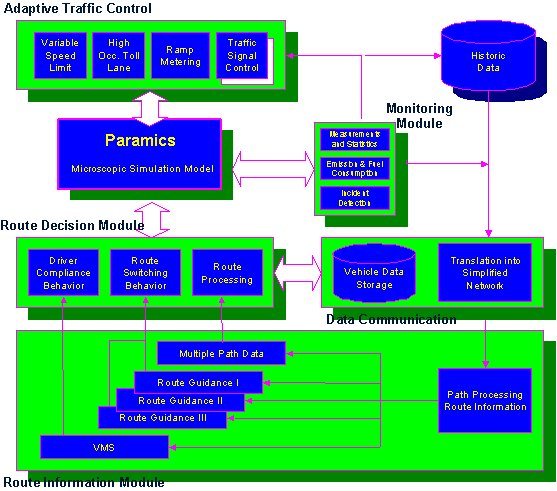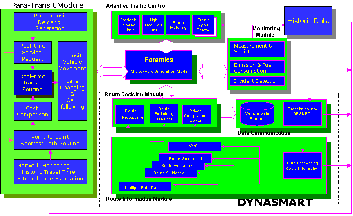Introduction
UCI-ITS is developing new algorithms for ATMIS applications and
testing them through microscopic simulation models. Currently UCI-ITS
utilizes Paramics as a base model for the analyses.
We have developed a library of plug-in modules to enhance and customize
Paramics using a Functional Interface or Application Programming
Interface (API). Various ATMIS applications are incorporated and
tested as in field operation.
Overall Framework
The Paramics' capabilities are enhanced with additional routines
added though the application programming interface (API). Since
various control strategies are tested and evaluated in the UCI ATMIS
testbed, flexibility and data interface are essential part of the
simulation model. In addition to the main Paramics module, the hybrid
simulation framework consists of five additional modules: (1) Monitoring,
(2) Adaptive Traffic Control, (3) Data Communication, (4) Route
Information, and (5) Route Decision. Each module consists of one
or multiple APIs. The individual APIs have their own functions interfacing
with other modules within the simulation framework. The flexible
nature of the model framework allows easy incorporation of new technologies
and algorithms into the model framework.

Monitoring and Adaptive Traffic Control
We have developed for ATMIS are travel time estimation or prediction,
O/D estimation, incident detection, etc. The monitoring routines
are also needed by the adaptive traffic control routines such as
for traffic signal control and ramp metering. Individual control
devices are modeled independently with APIs for devices such as
Type-170 controllers, interfacing with the monitoring module. APIs
for statistics are supplementary tools to measure emission and fuel
consumption, travel time statistics for individual vehicles, etc.
Data Communication
The objective of this task is to create a simplified network to
be used in route information and decision modules, but consistent
with the original one coded for running Paramics. In addition, the
process also requires the construction of a lookup table for communication
between the two networks, of information related to network level
variables like level of service, and also detailed information on
individual vehicle positions, speeds, route decisions, etc.
The equivalent abstracted network is made taking into account the
following possible simplification. In terms of link characteristics,
we aggregate across those Paramics links, whose end nodes represent
only a change in geometry or capacity than a real decision node
such as an intersection or an interchange. Calculation of link cost
in our abstract network is consistent with the Paramics link cost
calculation, which includes link costs themselves, and turn movement
costs. Look-up tables are used to identify the original links that
corresponds to the abstracted network links and to aggregate travel
times on them.
Route Information and Decision
The importance of path-based routing arises from the drivers' route
selection behavior comparing the routes in their mind with the routes
suggested by ATIS. In our framework, the path dynamics features
of DYNASMART are incorporated into the hybrid scheme via the Paramics
API capability.
The route information module has two folders. The first one is
initial route selection mechanism. Initial routes are assigned to
individual vehicles from a list of k-shortest paths based on their
levels of network familiarity that is assigned along with other
characteristics when the vehicle is generated. The vehicle's characteristics
and initial route are basis of route decision behavior. The second
folder is generation of route guidance. Main source of the route
guidance/information could be either path-processing procedure or
external algorithms. The route guidance/information can be generated
in various ways depending on their capability of network monitoring
and/or their objectives or algorithms. Allowing various guidance
types, the path processing/route information routine is capable
of using historic data as well as real-time data, though basic path
processing relies on k-shortest paths from real-time data. Further,
any dynamic route guidance generation algorithm such as DynaMIT
(4) or DYNASMART-X (5) can be incorporated via API in the route
information module and externally processed paths can be also directly
fed, while the data for the information generation are provided
from the monitoring module. Besides this route guidance that are
applied only to equipped vehicles, variable message signs (VMS)
provide unequipped drivers with route guidance/information. An algorithm
to generate VMS is also modeled via API within this route information
module. This feature allows Paramics to be a test-bed for the evaluation
of various route guidance systems.
Path-based Routing -- ParaDyn
The hybrid simulation approach integrates the PARAMICS microscopic
simulation with the routing and behavior response simulation schemes
as in DYNASMART, so that the integrated simulator can evaluate information/routing
schemes with route choice behavior models. This approach is based
on integrating networks of two different levels of abstraction and
communication of vehicle positions between the detailed network
(as in PARAMICS) to the more abstract network (as in DYNASMART).
The vehicle route decisions processed at abstract network are then
transmitted to the detailed network simulation that controls vehicle
movement at the microscopic level. The integrated simulation program
allows realistic evaluation of a variety of technologies in ATMIS.
Full-actuated Signal Control
Fixed-time signal control is provided by PARAMICS. PARAMICS also
provides a plan/phase language in MODELLER to make actuated signal.
However, it is difficult to use it for emulating the complex control
logic of Model 170 or 2070 type controller, which are widely used
in California.
This controller (eight-phase, dual-ring, concurrent controller
logic) has been implemented in this API. Each of eight phases accommodates
one of the through or left turning movements. The right turns are
omitted and assumed to proceed with the through movements. In full-actuated
signal control, all phases at an intersection are actuated, then
the length of each phase, and consequently the cycle length, will
vary with each cycle. Some phases may be skipped if there is no
vehicle actuation. To simulate the real controller better, the order
and sequence of phases can also be altered.
The data input to this API is the signal timing plan, the geometry
and detector information of each intersection. Interface functions
have provided by this API for external modules to acquire and change
the default timing plan.
Based on the API module of full actuated signal control, the signal
coordination logic is also implemented, with additional force-off
logic to maintain the background cycle length and form green band
for a particular phase (sync phase). This is used for emulating
the signal coordination of Controller 2070.
Time-based Ramp metering
A time-of-day basis ramp control on either a one-car-per-green
basis or a n-cars-per-green basis (with n > 1) is implemented.
There are two operation modes, fixed-time control and vehicle-actuated
fixed-time control.
The data input is a time-of-day ramp control plan. Any an external
module, such as a coordinated ramp metering algorithm, can communicate
with this API, i.e. getting the current ramp rate or setting a new
ramp rate to any a specific ramp meter, through interface functions
defined by this API.
Variable Message Sign Controller
This API module interacts ATMIS applications with VMS signs. Through
interface functions provided by this API, various ATMIS applications
can dynamically update VMS information and then affect driver's
behavior timely.
Loop Data Aggregator
PARAMICS can output two types of loop detector data for analysis:
· Point loop data, including flow, speed, headway, occupancy,
and acceleration of a vehicle, and
· Link loop data, including flow, average speed, density,
lane use, and lane changing on a link.
Point data is gathered at every time step when an individual vehicle
passes over the loop; link data analyses the traffic data over a
link, where loops locate, at a user-defined time period. However,
many ATMIS applications demand point traffic data, but in an aggregated
manner over user-defined time intervals, e.g. 30 seconds.
Loop data aggregator emulates the outputs of real-world data collection
from induction loops, through gathering point loop data at each
time step of simulation and then aggregating at any time interval
specified by users. The gathered data can be raw data or smoothed
data in term of user's choice. Aggregated loop data (including volume,
occupancy, speed) can be output to text files or MYSQL database,
and can be also accessed by interface functions defined in this
API.
MySQL Database
A series of interface functions has been developed using MYSQL
API functions for the purpose of connecting PARAMICS simulation
environment with MYSQL database. This will fit to the need of storing
large volume of data during the simulation process.
CORBA Interface
The API implements and generates a set of server objects for the
relevant objects in the loaded simulation based on CORBA naming
service. In this way, PARAMICS could be connected to other field
device objects, or other ATMIS modules.
Performance Measure
PARAMICS provides a variety of measures of effectiveness (MOE)
such as vehicle flow, delay, loop count, occupancy, turning counts,
etc. The function of this API plugin is to provide more user-preferable
measures and some measures that cannot be provided by PARAMICS directly.
Due to the randomness of micro-simulation, a measure of the system
performance for the whole network should be provided All vehicles,
including those having finished their journey and those currently
simulated, are all considered in this measure.
Other measures in this API include:
- Average on-ramp waiting time, which is a measure evaluating
the effect of ramp control to the traffic flow on entrance ramps.
- Average OD travel time, which considers the average travel time
for vehicles between a specific OD pairs. Note that we use this
measure to evaluate the effect of control on vehicles from an
entrance ramp to the downstream end of the freeway.
- Intersection delay, which can report the delay information,
including average stop delay, control delay, queue length of each
approach, average travel time of a movement of an intersection
at a certain aggregation level.
Paratransit Routing
Based on the ParaDyn's path-based routing capability, this API
enables a dynamic paratransit simulation. While the transit routing
decision is made via a real-time point-to-point shortest path algorithm,
the transit in the simulation model moves along the simulation network.
The optimal routing decision is made based on individual vehicle's
position, passenger calls, and real-time traffic condition. Passenger
demand generation and performance measure are embeded in the simulation
framework.
 <Click
the figure to enlarge> <Click
the figure to enlarge>
|